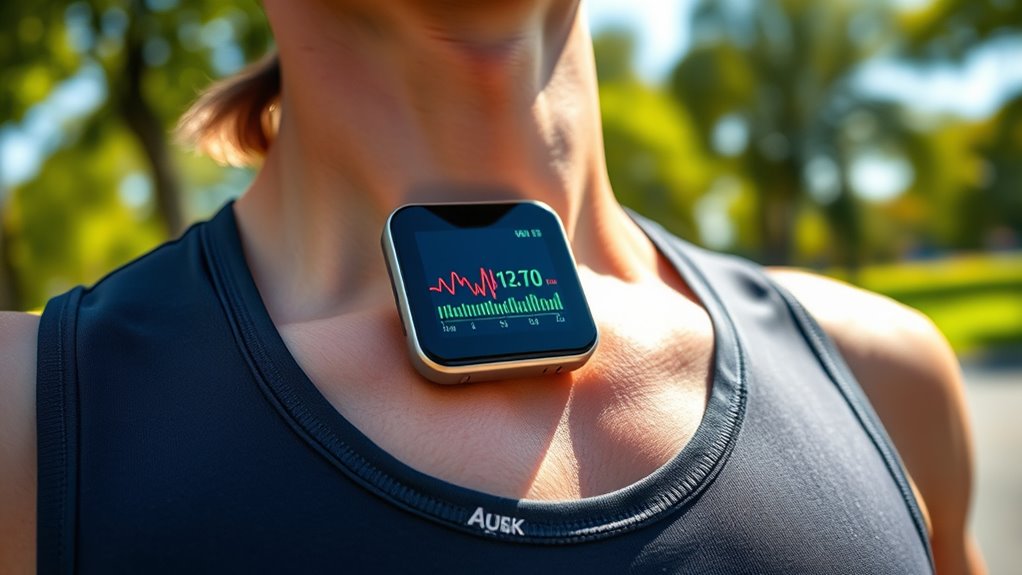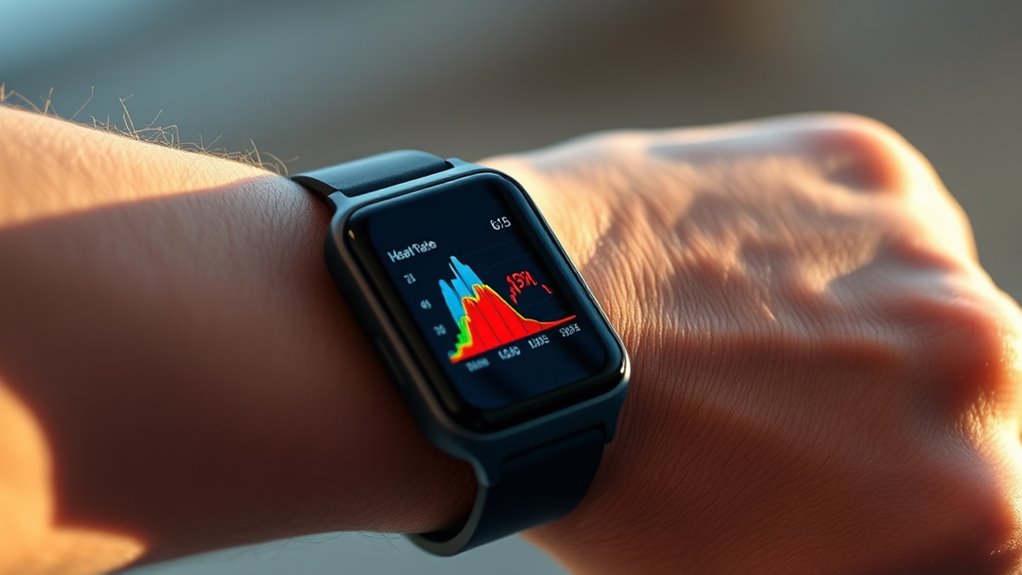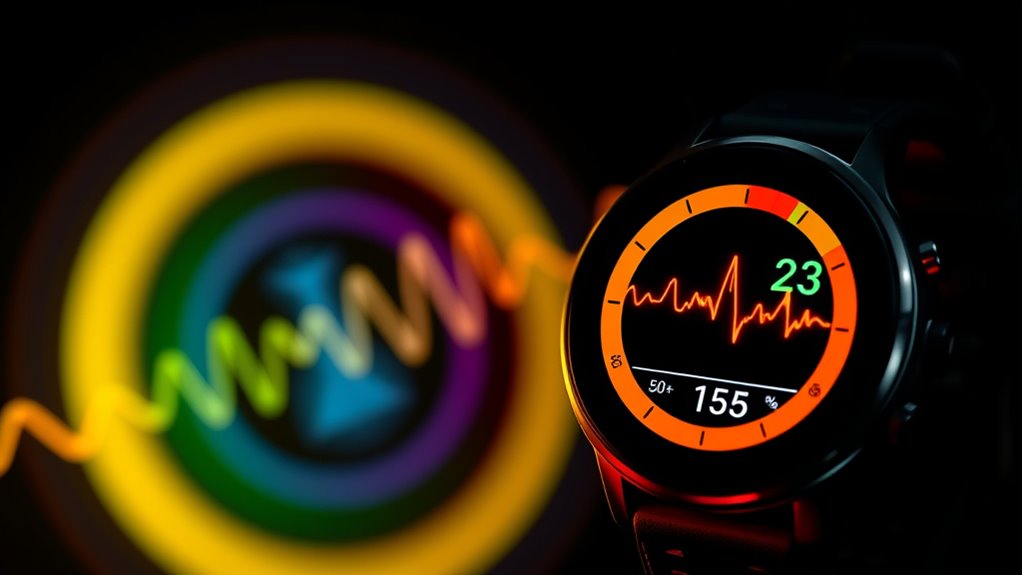To calculate your heart rate zones, start by determining your maximum heart rate with the simple formula: 220 minus your age. Measure your resting heart rate first thing in the morning to understand your baseline. Then, multiply your maximum heart rate by specific percentages (50-60%, 60-70%, etc.) to find your target zones for fat burn, cardio, and peak effort. Using proper tools and consistent methods guarantees you hit the right intensities—if you’d like more tips, keep exploring how to optimize your workouts effectively.
Key Takeaways
- Calculate your maximum heart rate using the formula: 220 minus your age.
- Determine target heart rate zones by multiplying your maximum heart rate by specific percentage ranges (50-60%, 60-70%, etc.).
- Measure your resting heart rate consistently to personalize your zones and monitor fitness progress.
- Use heart rate monitors or wearable devices to stay within desired zones during workouts.
- Adjust your effort in real-time based on heart rate feedback to optimize training effectiveness and safety.
Understanding Heart Rate Zones and Their Benefits

Understanding your heart rate zones is essential for optimizing your workouts and achieving your fitness goals. When you train within specific zones, you access different cardiovascular benefits that enhance your overall health and performance. Zone training helps you target various intensity levels, whether you’re improving endurance, burning fat, or increasing your aerobic capacity. By staying in the right zone, you guarantee your heart works efficiently during exercise, promoting better circulation and heart health. Knowing how to identify your zones allows you to tailor workouts that match your fitness level and objectives. This targeted approach maximizes results while reducing the risk of overtraining or injury. Ultimately, understanding your heart rate zones empowers you to make smarter, more effective choices during every workout session.
How to Calculate Your Maximum Heart Rate

To find your maximum heart rate, you can start with simple methods like using an age-based formula or consider more accurate heart rate testing options. Measuring your resting heart rate can also help refine your target zones. Knowing these numbers helps you train safely and effectively within your ideal heart rate zones. Additionally, understanding your heart rate zones allows for more precise training adjustments. Modern fitness devices and wearable technology can assist in tracking these vital signs accurately during workouts.
Age-based Estimation Method
Estimating your maximum heart rate is a straightforward process that can help you tailor your workouts effectively. The age-based estimation method is one of the simplest ways to do this. It relies on a basic formula: subtract your age from 220. This provides an approximate maximum heart rate, suitable for most people. Keep in mind, fitness level considerations can influence how accurate this estimate is—some individuals may have slightly higher or lower max heart rates. While this method is quick and easy, it’s important to remember that it offers a general guideline rather than an exact number. Use it as a starting point, and consider more precise testing if you want tailored heart rate zones for your specific fitness goals. Recognizing soulmate angel numbers can also serve as a motivational sign to stay committed to your fitness journey. Additionally, understanding how heart rate zones influence workout intensity can help optimize your training effectiveness. For a more personalized approach, consulting with a fitness professional or using heart rate monitor devices can provide more accurate data. Knowing your resting heart rate can also help you track your cardiovascular health and progress over time.
Heart Rate Testing Options
There are several methods you can use to determine your true maximum heart rate beyond the basic age-based formula. Wearable devices, like fitness trackers and smartwatches, can monitor your heart rate during intense exercise to estimate your maximum. These devices often include built-in tests or algorithms that guide you through maximal effort efforts to get a personalized reading. For more precise results, lab testing is also an option. In a controlled environment, exercise physiologists can perform stress tests to measure your heart rate response under maximum exertion, offering the most accurate data. While wearable devices are convenient and accessible, lab testing provides detailed insights, especially if you need highly accurate measurements for training or medical reasons. Understanding your heart rate zones can help you optimize your workouts and improve overall fitness. Additionally, lifestyle factors such as sleep, nutrition, and stress levels can influence your heart rate data and overall performance. Incorporating technological advancements can further enhance the accuracy of your heart rate assessments. Moreover, advances in AI technology are being integrated into health devices to better interpret heart rate data and provide personalized fitness recommendations.
Using Resting Heart Rate
Your resting heart rate offers a simple yet effective way to estimate your maximum heart rate, aiding your overall heart health and fitness assessment. To determine it, measure your pulse first thing in the morning before getting out of bed, counting beats for 60 seconds. Once you have your resting heart rate, subtract it from 220 to estimate your maximum heart rate. This calculation provides a baseline for setting personalized heart rate zones for training. Knowing your maximum heart rate helps you target the right intensity during workouts, improving cardiovascular fitness and reducing the risk of overtraining. Regularly monitoring your resting heart rate can also indicate changes in your heart health and fitness level over time. It’s a quick, non-invasive way to get valuable insights into your cardiovascular health. Incorporating accurate measurement methods can improve your assessment’s reliability and effectiveness. Additionally, understanding how tuning modifications can influence your vehicle’s performance can serve as a useful analogy for optimizing your fitness routine through precise monitoring and adjustments.
Determining Your Resting Heart Rate

To find your resting heart rate, you need to measure it first thing in the morning while you’re still lying down or relaxed. Your ideal resting range varies based on factors like age, fitness level, and health. Understanding these influences helps you accurately determine your resting heart rate and track changes over time. Incorporating natural techniques such as consistent measurement methods can improve the accuracy of your readings. Developing mindfulness practices can also help you become more aware of your body’s subtle signals, leading to more precise measurements. Using reliable measurement tools ensures your readings are consistent and accurate. Additionally, understanding how automation in business can streamline health monitoring processes emphasizes the importance of consistent data collection.
Measuring Your Heart Rate
Measuring your resting heart rate is a simple yet important step in understanding your cardiovascular health. You can do this by locating your pulse, typically on your wrist or neck, and counting the beats for 15 seconds, then multiplying by four. Using a device like a pulse oximetry monitor can provide an accurate measurement and help track changes over time. Your resting heart rate offers insight into your aerobic capacity, reflecting how efficiently your heart functions at rest. Regularly monitoring it helps identify trends and potential health issues early. Remember, your resting heart rate is best taken when you’re relaxed, sitting quietly, and haven’t recently exerted yourself. Accurate measurement is essential for setting realistic fitness goals and tracking your progress effectively. Incorporating performance tuning principles can also help optimize your body’s overall efficiency, including heart function, by ensuring your physical systems operate smoothly. Additionally, understanding your heart rate zones can guide you in tailoring your exercise intensity for optimal benefits. Monitoring your heart rate can also reveal how diet and lifestyle choices impact your cardiovascular health over time.
Ideal Resting Range
Understanding your ideal resting heart rate helps you gauge overall cardiovascular health and fitness. Your resting heart is the number of beats per minute when you’re at complete rest, typically measured after waking up. A lower resting heart usually indicates better heart efficiency and cardiovascular fitness. To determine your ideal range, track your resting heart over several days, ideally in the morning before getting out of bed. Pay attention to your heart rate variability, which reflects the fluctuations between beats and can signal your body’s stress and recovery levels. A consistent resting heart within the normal range suggests good heart health. Monitoring your resting heart rate can also help you identify early signs of health issues, including potential risks related to mammography guidelines or other health screenings. Remember, individual factors matter, so use your resting heart as a personalized benchmark to monitor your fitness progress over time. Additionally, vetted home theatre projectors can enhance your workout space for guided fitness routines at home. Keeping an eye on your resting heart rate can also help you assess how well your investment in personalized health strategies are working over time.
Factors Affecting Resting Rate
Various factors can influence your resting heart rate, making it essential to consider them when determining your baseline. Stress factors, such as anxiety or work pressure, can elevate your heart rate even when you’re at rest. Poor sleep quality also plays a significant role; if you don’t sleep well, your heart may beat faster during your quiet moments. Additionally, dehydration, caffeine intake, and recent physical activity can temporarily increase your resting rate. It’s important to measure your resting heart rate when you’re calm, relaxed, and in a consistent environment for accuracy. Tracking these influences helps you establish a true baseline, enabling more effective use of heart rate zones during exercise. Recognizing these factors ensures your measurements genuinely reflect your resting condition. Cookies can also impact your overall health and wellness by influencing stress and sleep patterns, which in turn affect your heart rate. Ensuring a consistent measurement environment helps improve the reliability of your resting heart rate data.
Identifying Your Heart Rate Zone Percentages

To accurately identify your heart rate zone percentages, you need to determine your maximum heart rate first. Your maximum heart rate serves as the foundation for zone identification, helping you understand how hard you’re working during exercise. To find it, subtract your age from 220, or consider a fitness test for more precision. Once you have this number, you can calculate your heart rate percentage for each zone by multiplying your maximum heart rate by the desired percentage range. For example, if your max is 180 bpm, 50-60% zone would be between 90 and 108 bpm. This process allows you to clearly define your target zones, making your workouts more effective and tailored to your fitness goals. Accurate zone identification ensures you’re training at the right intensity.
Applying Heart Rate Zones During Your Workouts

Applying heart rate zones during your workouts guarantees you train efficiently and safely. By using your target zones, you can structure interval training sessions to maximize benefits while minimizing injury risk. For example, during high-intensity intervals, push into your anaerobic zone for a set period, then recover in a lower zone. Proper interval timing guarantees you’re not overexerting or undertraining. Keep an eye on your heart rate monitor to stay within the desired zone, adjusting your effort as needed. This approach helps improve endurance, speed, and overall fitness. Remember, consistent monitoring and adjusting your intensity based on your heart rate zones make your workouts more effective. Applying these principles ensures you get the most out of every session while staying safe.
Tips for Monitoring and Adjusting Your Intensity

Monitoring and modifying your workout intensity in real-time guarantees you stay within your target heart rate zones for maximum benefit. During interval training, pay close attention to your heart rate to switch between high and low-intensity phases effectively. Using a heart rate monitor helps track your heart rate variability, signaling when to push harder or ease up. Adjust your pace or effort based on how your body responds, especially if you notice irregular heart rate patterns. Incorporate regular check-ins, like quick pulse assessments or device alerts, to stay on track. Remember, consistent monitoring allows you to optimize training, prevent overtraining, and improve overall performance. Staying attentive ensures you maximize the benefits of your workout while maintaining safety.
Frequently Asked Questions
How Often Should I Reassess My Heart Rate Zones?
You should reassess your heart rate zones every 6 to 8 weeks to maintain training consistency and adjust for fitness improvements or changes. Regular reassessment helps account for the nutrition impact on your performance, ensuring your zones stay accurate. If you notice plateaus or fatigue, consider more frequent checks. Staying on top of your zones optimizes training effectiveness and prevents overtraining or injury, keeping you progressing toward your goals.
Can Heart Rate Zones Improve Athletic Performance Significantly?
Yes, heart rate zones can markedly boost your athletic performance. By incorporating interval training within specific zones, you challenge your body and improve speed and stamina. Using zones for endurance building helps you train smarter, avoiding overtraining and optimizing recovery. When you tailor workouts to your zones, you maximize results, enhance overall fitness, and push your limits more effectively. Consistent zone-based training is a game-changer for serious athletes.
Are There Any Risks Associated With Training in High Heart Rate Zones?
You might think training in high heart rate zones is safe, but it can pose overtraining risks and increase cardiovascular strain if done excessively. While pushing your limits can boost performance, overdoing it may lead to fatigue, injury, or long-term heart issues. Always listen to your body, incorporate rest, and consult a professional to avoid these risks and guarantee your high-intensity workouts remain safe and effective.
How Do Medications Affect My Heart Rate Readings?
Medications can substantially impact your heart rate readings by altering your heart rate variability and overall response to exercise. Some drugs, like beta-blockers, lower your heart rate, making it harder to reach certain zones or accurately gauge effort. Others may cause fluctuations. Always inform your healthcare provider about any medication impact on your heart rate to ensure safe training and proper interpretation of your heart rate data.
What’s the Best Time of Day to Measure Resting Heart Rate?
Imagine your heart as a vintage radio, tuned just right. The best time to measure your resting heart rate is in the morning, ideally during fasting conditions. Right after waking up, before moving around or having coffee, gives you the most accurate reading. This way, your heart rate reflects true resting conditions, helping you monitor fitness progress or detect early signs of health issues effectively.
Conclusion
By understanding and accurately calculating your heart rate zones, you can optimize your workouts and improve your fitness efficiently. While some believe training in specific zones guarantees faster results, research suggests that variety and consistency are just as essential. So, don’t rely solely on zones; listen to your body, stay consistent, and trust that a balanced approach often leads to the best long-term gains. Your effort, combined with smart zone use, truly makes a difference.









